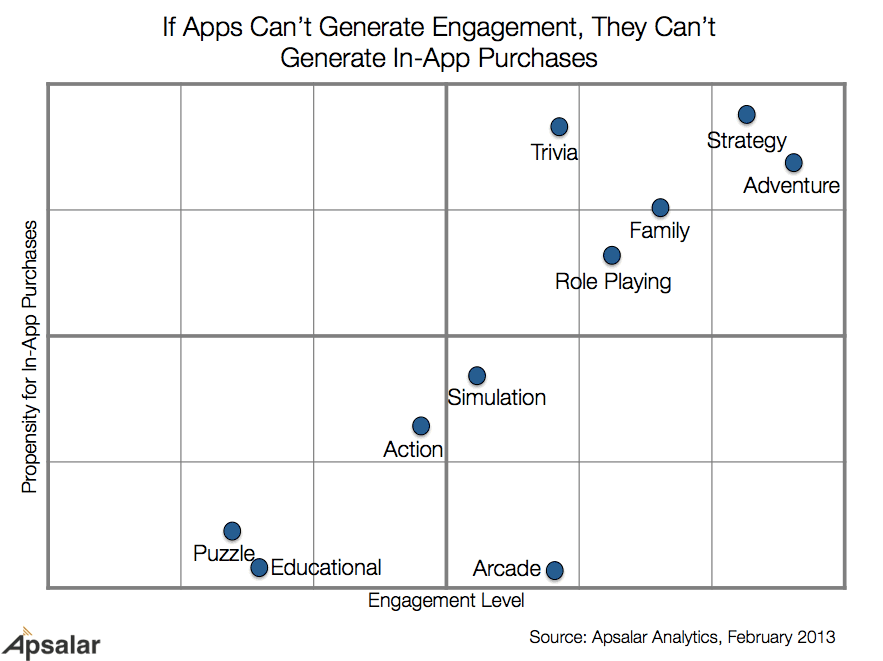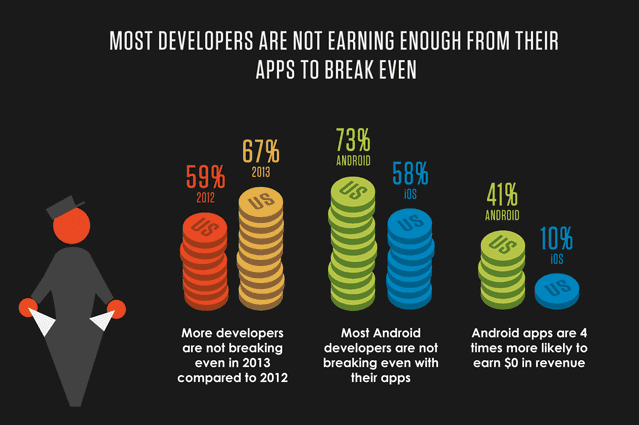Recent Posts of Revenue

18 June, 2013
Data from Apsalar’s Big Data Lab reveals the game categories with the highest propensity for in-app purchases. As it turns out, strategy games are more than 18x more effective at driving IAP than arcade games! In-app purchases are also strongly correlated with engagement (as measured by average daily session length). Yet another proof point that user engagement is a key ingredient in any app monetization strategy.

10 June, 2013
4 out of 5 developers admit that their app doesn’t make enough money to be considered a standalone business. 2 out of 3 doesn’t break even. And yet there is hope.

17 April, 2013
Advertising is the most popular revenue model, while ads can also act as a promotion channel that facilitates app discovery. With 100+ ad networks and exchanges, there is intense competition, regional specialisation and niche solutions, but out of the fray, one service emerges as a leader: AdMob.

15 April, 2013
When viewed as just another form of advertising, with a cost-per-action model, in theory Cross-Promotion Networks should work out fairly well for developers. User acquisition costs are predictable for advertisers and those displaying ads have reasonably good targeting built-in before any extra targeting logic used by the cross-promotion network – everyone viewing the ad has a smartphone and downloads apps on it! How does the theory work out in practice?

09 April, 2013
How do app developer revenues vary by country, or platform? Does the number of platforms make a difference to app revenues? Which models bring in the most revenues? We revisit Andreas Pappas’ November analysis of app monetisation with more insights from our Developer Economics 2013 survey across 3,400+ developers.

08 April, 2013
Of the tools and services for developers we asked about in our last survey, one category stands out by miles as having the wealthiest developers: voice services. Of course there’s a lot of variety in the voice services sector and the revenue is not at all evenly distributed.

02 April, 2013
There are a wide variety of products that can be considered Backend-as-a-Service (BaaS) offerings. At the time of writing we list 43 of them on our sector summary page. We have previously discussed whether or not they’re a good idea and how much development effort you could save by using one. In our most recent survey we asked developers about their use of some of the most popular options. By comparing developers’ use of BaaS with their average revenues and active user bases, we can determine how well these products are working for them.

25 March, 2013
On the surface, advertising seems like a fairly simple and easy to implement business model for an app. Decide on some places to display ads, integrate one or more third party ad services and wait for the money to start rolling in. If you do this without a clear plan for how and why users will interact with ads in your app you’ll probably find the revenue disappointing. Optimise revenue by growing your user base, increasing engagement…

18 March, 2013
Creating a successful app business takes a lot more than a good idea and the skills to develop an app and upload it to a store. As we’ve discussed before, developers who promote their apps are almost 3 times as likely to break-even as those who don’t. This is the simplest difference with a massive effect on success. It seems obvious…

15 March, 2013
[Geroge Karavias, co-founder of Anlock, shares his experiences in marketing kids’ educational apps and proposes a survivor kit to keep in mind when navigating the treacherous waters of this category.] You might have started thinking that putting together an educational app may not be such a bad idea, I mean how hard can it be? Of the App Store’s top 200 paid list of iPad educational apps, 70% are kids’ educational apps. Out of these, roughly 80% are by independent developers…